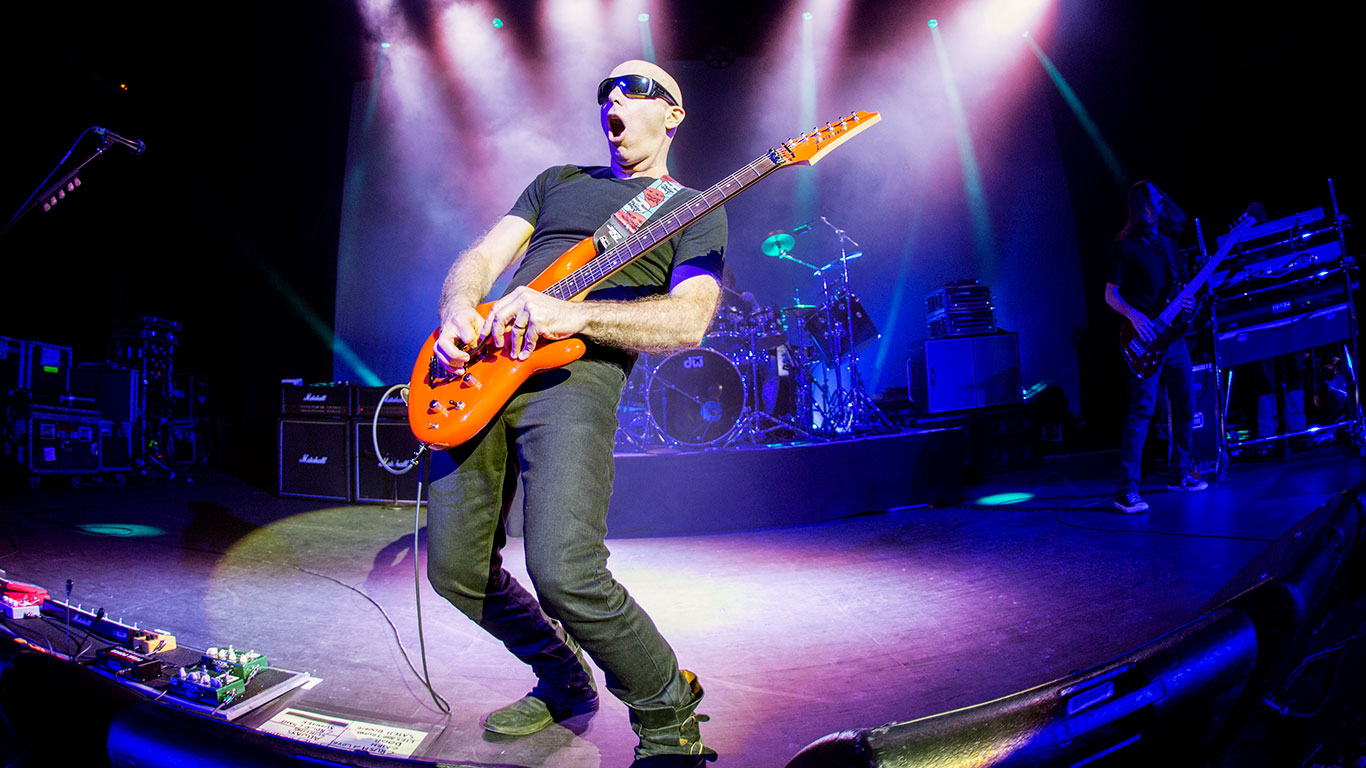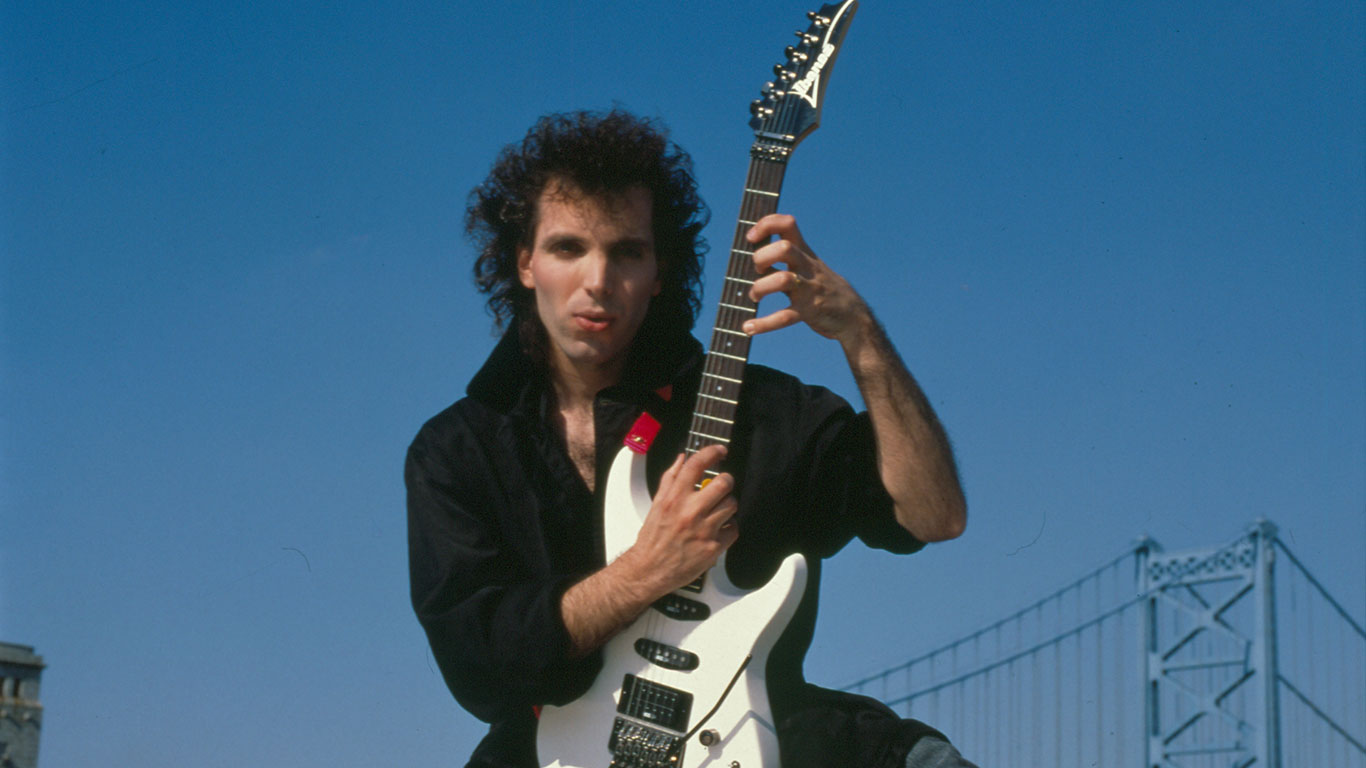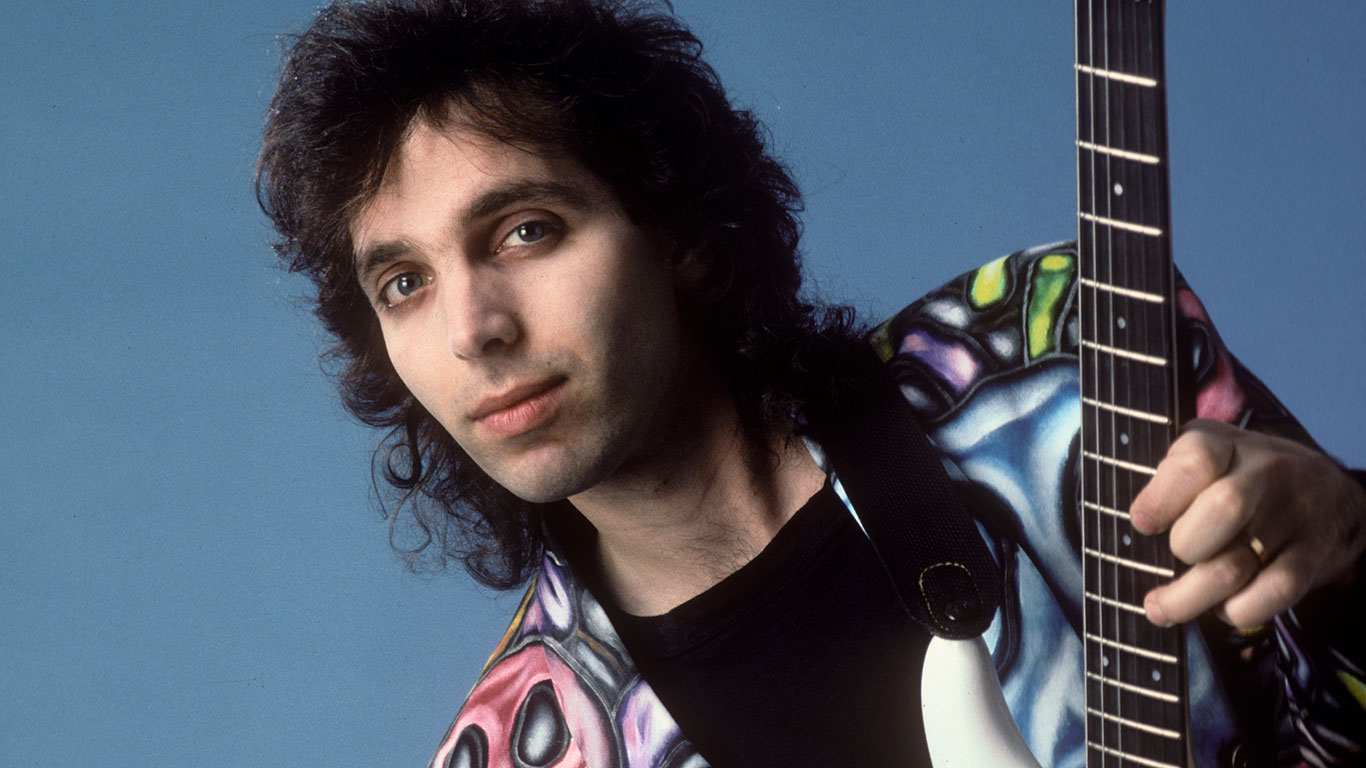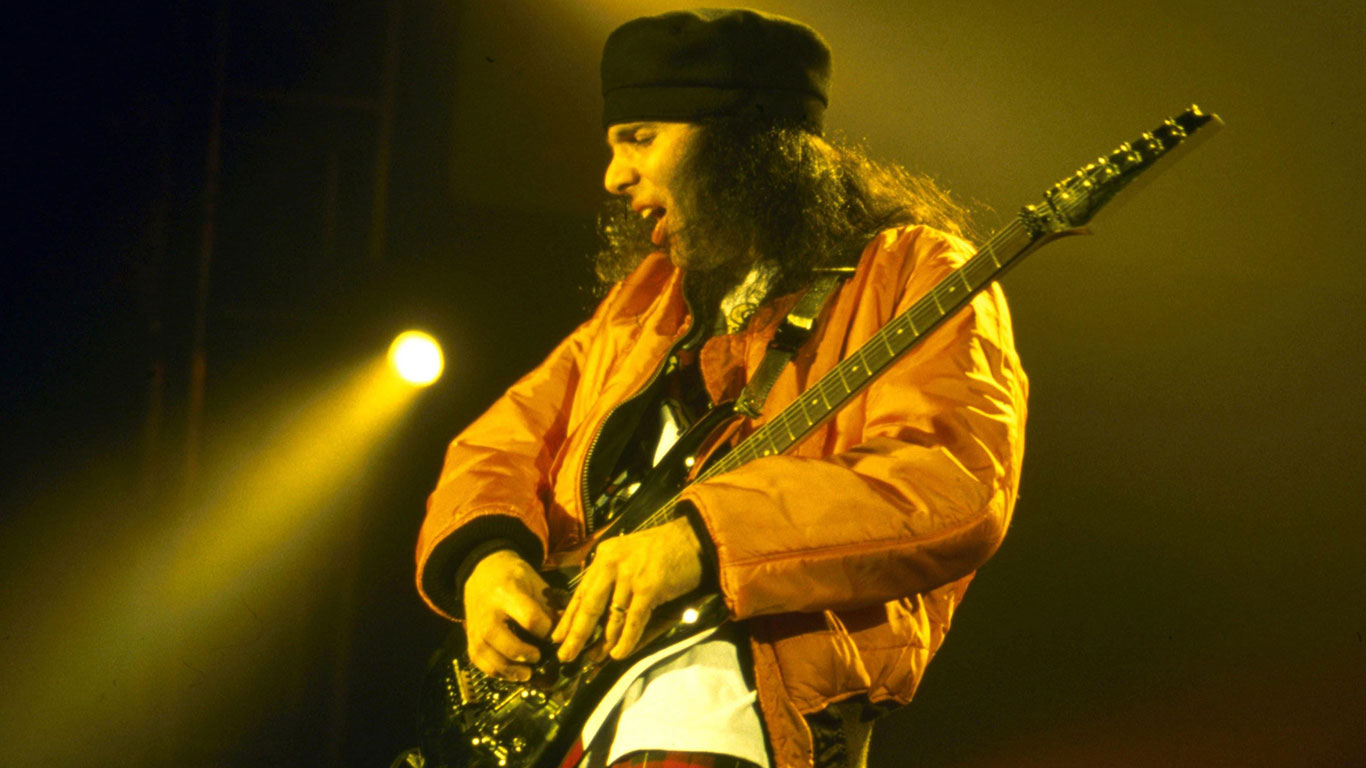Joe Satriani Reflects on 20 Years of Surfing With the Alien
“I didn’t want my follow-up album to be a weird, quirky record”

“I didn't want my follow-up album to be a weird, quirky record... like my proper debut, Not of This Earth,” says Joe Satriani, settling into a chair inside his San Francisco home studio.
“I wanted my next record to be blown up to its full potential. I mean, why couldn’t an instrumental guitar record rock like Queen or the Pretenders, and have the energy of Van Halen? So once I got the go-ahead to make Surfing with the Alien, I felt like the luckiest guy in town.”
Satriani then proceeded to drop the 6-string equivalent of an atomic bomb. Surfing with the Alien became the first rock guitar instrumental album to reach Billboard’s Top 200 Album Chart, topping out at number 29. It also spawned three hit singles, and the album was ultimately certified platinum.
All this from a guy who a year earlier was arguably more popular for giving lessons to Steve Vai and Kirk Hammett than he was for his own playing.
Soon enough, the masses learned that Satriani was an amazing guitarist—more than worthy of all the effusive praise his star pupils heaped upon him. What they may not have known is that he was poised to rewrite the book when it came to modern instrumental rock guitar, as he brought a pop sensibility along with good old-fashioned chops, and an ear for the exotic.
It has been 20 years since Surfing with the Alien was released, and Epic/Legacy is commemorating the anniversary with a remastered and expanded CD/DVD set that also contains Satriani’s performance at the 1988 Montreux Jazz Festival.
“We went into the Surfing sessions knowing we wanted to keep the album bright and upbeat,” explains Satriani, as we sit amongst a slew of prototype signature gear. (He was burning-in an upcoming Peavey JSX amp design and tweaking a Vox signature wah.) “But when we got serious, we decided to make the album truly cinematic, and I think this is why it’s still inviting to listeners.
We didn’t just hit them over the head with ‘Listen to what I can play.’”
By 1987, there were quite a few instrumental guitar albums out, but Surfing was nothing like them.
Instrumental guitar/shred records at that time struck me as very serious, and not very inclusive propositions. I always got the vibe that you had to buy into a certain style of music and reject everything else in order to really appreciate what was going on. Whether it was death metal, shred, or pure fusion, it seemed like each guy was thumbing his nose at the other. I wanted to celebrate all aspects of the guitar. I wanted to be able to play like Chuck Berry or Hendrix, make weird noises, and also play traditionally. I wanted to play a ton of notes, and then play too few.

Did the desire to create a more inclusive, inviting record affect the songwriting process for Surfing?
I think it gave me a bit more courage to be simple. Take “Always With Me, Always With You.” It’s a simple I, IV, V progression, but I subverted it a bit by giving every chord a suspended tonality. I would add, say a 4 to one chord, and a 13 to another. Then, I composed a section using pitch axis theory [a compositional technique most notably used on the title track of Satriani’s Not of This Earth where different modal harmonies revolve around one tonal center] to take the song even further out of the I, IV, V arrangement. I wanted to do the same thing with “Satch Boogie.” I started out taking a ZZ Top/Van Halen-style-boogie, and injecting this warped two-handed tapping thing in the middle. But the devil on my shoulder urged me to do more, so I used pitch axis theory again. As a result, the notes that make up the two-handed arpeggios in that section create some very odd tonalities that you wouldn’t hear on a ZZ Top album. I suppose I was negotiating artistic licenses in my twisted brain at the time, thinking if I put one foot in the mainstream, I could stick the other in the avant-garde.
How did the solo two-hand tapping piece “Midnight” come about?
“Midnight” was totally written in musical notation. It was all in my head—I didn’t even have a guitar in my hands, so there was no regard to playing it with two-hand tapping. Once I felt it was a nice piece of music, I decided I didn’t want to strum chords and play the melody over the top. So I figured out a way to play both parts using two-hand tapping. That took a long time. I had been experimenting with tapping, but I really wanted to go a different direction than Van Halen, who typically tapped single-note lines. I didn’t want to step into his territory. Thankfully, working that tune up to speed got me going in a totally different direction. It’s interesting that, by not approaching it from a technical point of view originally, I was actually pushed into expanding my technique, because I didn’t have the ability to two-hand tap it when I first wrote it. The track “Hill of the Skull” was written on manuscript, as well.
Did you have a game plan for the album’s guitar tones?
By the time I started making solo records, I had developed some pretty bad attitudes towards vintage gear and the vintage cognoscenti. I think it stemmed from the fact I was working at a vintage guitar store—Second Hand Guitars in Berkeley—and I was broke. But back then, I only thought about music. So, in a way, I became “Mr. Contrarian” when it came to tone. With Surfing, I went in with a Roland JC-120 and a ’68 Marshall half-stack that was modded with a master volume. I also used original Chandler Tube Drivers, a Boss DS-1 and an SD-1, a Scholz Rockman, a Nomad amplifier, and a borrowed bass amp.
For vintage tone guys, this was blasphemy. You don’t get big guitar sounds from Boss pedals and a Rockman! People always asked me if I wanted to borrow their Hiwatts and Les Paul Juniors, and I’d always say “no.” As long as the material you’re presenting asks for an interesting take, then you can go cheap or expensive. It doesn’t matter whether you use a ’55 Strat or a Kramer Pacer.
Did the Rockman tones make you play differently?
Oh, yeah. Take the solo on “Crushing Day,” for example. That was the only worked-out solo on the record, and it sports a very obvious Rockman tone. But I like the way the Rockman just emasculates the tone. I could never have played the solo the way I did with natural tube distortion through a 4x12 cabinet, because there would be too much sonic information. The low strings would be huge and boomy, and the high-end would be screaming. But the Rockman creates a “tunnel vision” of sound that evens everything out. The low notes and high notes were all equal volume. So for legato technique, it was great. It kind of makes you feel like Allan Holdsworth!
Do those sounds still hold up for you?
Most of them do. There are some Rockman tones from Not of This Earth that I don’t feel were the best application, but by the time I did Surfing, I had refined my Rockman use to the point of feeling emboldened. You have to remember—we didn’t have the budget to spend a week getting guitar sounds. There weren’t six different speaker cabs and a bunch of exotic amplifiers lying around. We had a modest studio with a small amount of time and a tight schedule.
Is it possible that time and budget constraints actually affected the record in a positive way?
Without a doubt! Surfing was made without any lockout time—meaning that we didn’t have the studio completely to ourselves throughout the recording process. We’d have, say, four hours on Wednesday, then we’d only be able to get back in, say, for six hours the next Thursday—but in a different studio room down the hall from where we recorded on the other days. In addition, the studio owner was an avid gear collector, so pieces of outboard gear would be coming and going at such a rate that you never knew if the same reverb or flanger would be there when you came back! We were also renting a lot of gear.
This is why we always printed our effects to tape when we tracked. One particular instance where printing saved us was on the album’s title track. We stumbled onto this sound, which was the Kramer through the Tube Driver, a Vox wah, and the Marshall. But we also ran through an Eventide H949 Harmonizer for a slight pitch modulation. However, this particular unit was on the fritz. It was acting very finicky, and its pitch settings would jump around randomly. We really dug the way it sounded, but not only was the Eventide not long for this world, our time was up, and there were people outside the studio door waiting to start their session. Well, 20 minutes later, the Eventide died, but we had our take, and we had printed the effect. We had actually forgotten about it, but when we brought those faders up later during the mixdown, it was like found art.

After you finished Surfing, the label wanted you to hit the road to support the album. Was the prospect of not only leading your own band, but fronting it a bit daunting?
Very much so. When the record company called and said I had to hit the road, my response was, “You’ve got to be kidding—do I just walk up there and play without a singer?” I mean, I’d seen Jeff Beck and Mahavishnu Orchestra live in the ’70s, but that was a long time ago. People just didn’t do that anymore! I’d been playing clubs for five years, and I didn’t see one instrumental act. There was no market for it. Who was going to hire us? So I had to dig deep, and figure out how I was going to stand in front of a crowd and just play. So we booked a two-week tour, and I assembled a trio with Stu Hamm on bass and Jonathan Mover on drums, and we got to it.
How were those first shows?
They were difficult, because I went into them a bit stressed from just finishing Surfing, and getting a good reaction from it, yet still being another struggling musician teaching guitar. I never thought I would be the guy who had to set the tone for an organization. Playing with John and Stu was great. They’re amazing musicians, but they’re not rock and roll guys at all. I think when they listened to Surfing, they thought to themselves, “C’mon, this is so simple.” So when we hit the stage, they were very interested in subverting the tunes—in a good way, of course—but they had their way with the music nightly, and that was a struggle at times. I kept telling them, “Think Chuck Berry and Led Zeppelin. This isn’t a fusion festival!” In fairness to them, however, I was figuring out the whole bandleader/solo artist trip, as well. There were definitely times we were at each other’s throats.
Before we finished those shows, I received a call from Bill Graham’s people that Mick Jagger needed a guitarist for his solo tour. Jagger’s bassist—Doug Wimbish—referred me. Thankfully, I got the gig, and that solved the fiscal problems my own tour was causing. Because even though Surfing was in the early stages of blowing up, I wasn’t seeing any money. It can take up to 18 months for the royalties to start coming in. But thanks to Mick, I’m in Rolling Stone, and playing in front of a lot of people. It was a big relief, because I felt like I didn’t have to lift my solo career up off the ground all by myself. By the time the Jagger tour was over, Surfing had really hit. Suddenly, promoters and venues were calling for my band. The next thing I know, we’re doing two shows a night, six nights a week, for two months solid. We worked ourselves to death.
Did Jagger impart any nuggets of wisdom in regards to performing?
Oh, yeah. I’ll never forget how I would just be noodling around on the guitar in the rehearsal room, and he’d come right up next to me and just start singing. That made me relax, and say to myself, “Man, I shouldn’t be so guarded about my creativity. Mick Jagger isn’t guarded. So why am I?” That allowed me to get on stage and really open up to the audience. And when he hit the stage, you learned the meaning of “projection” real quick. The joke was that you could stand next to him, light yourself on fire, and the audience would still be watching Mick. He has that power.
Surfing undoubtedly put you atop the instrumental rock guitar heap. As a predominantly instrumental artist, what instrumental works do you hold in high regard?
I’ve always said that Santo & Johnny’s “Sleepwalk” is quite possibly the quintessential instrumental arrangement. It’s such a beautiful, simplistic statement. Conversely, dig into “Frankenstein” by Edgar Winter. It’s a lot different than “Sleepwalk,” yet it still has a pop sensibility—even though it took extraordinary musicianship to arrange it, write it, and play it. But at the end of the day—even for the instrumental stuff—I’m all about Hendrix. He has always been the guitarist who has reached me the most. When I think about instrumentals, I think about “Third Stone from the Sun.” I mean, there’s so much going on, yet it’s loose and devastatingly intense. It was played with great spirit, and it wasn’t pored-over to death. His studio version of “The Star Spangled Banner” and “1983 … (A Merman I Should Turn to Be)” are unreal. I would listen to that stuff for hours, and it would unlock these desires in me to try and create—with my own music—the experience of being a listener and getting off.
Surfing also highlighted your legato technique—particularly with the lyricism of “Always with Me, Always with You.” Is there a reason why you went the more legato route, as opposed to alternate picking?
I never liked the strict alternate-picked style. My favorite players were Jimi Hendrix and Jimmy Page—guys who I thought made great music. There were other impressive guitar players with more chops, but when the technical guys played, I had visions of upstrokes and downstrokes and sixteenth-and thirty-second-notes in my head. When Hendrix played, that stuff never entered my mind. It’s the same with Brian May and Jeff Beck. I was more into the purely musical side of the instrument, so I struggled with how to get good without having a “method.” If someone wants to play really fast up and down the neck, you can get the learning material, practice six hours a day, and, in two years, you’ll probably see some amazing results. But there’s no method to playing like Hendrix. There’s no creative method to Page’s studio wizardry. So I would just play along with their records—playing as freely as I could—in an effort to encourage and embrace my own quirkiness as a player.

The screaming and squawking artificial harmonics have always been a big part of your sound. On “Ice 9” you even use them to elicit some cool, barky overtones from chords. Who was the first player you heard that used them?
Billy Gibbons. I’ve always loved the way he plays, and I’m floored by the way he writes. His approach in the studio over the years is outstanding, and it’s always surprising, as well. Have you heard the song “Loaded” from Rhythmeen? That is one of the coolest things I’ve heard a guitarist do ever—an actual broken guitar sound. And no matter what he plays, it always swings. I’d also heard Roy Buchanan use pinch harmonics, but, although I could appreciate it, I couldn’t relate to his style of music or his look. I was a long-haired rock guy. Jimmy Page and Tony Iommi used pinch harmonics to great effect, as well.
Surfing also sports a ton of outro solos—what inspired that arrangement decision?
Oh, yeah. On “Surfing with the Alien,” the outro is almost as long as the song! It’s funny, because even though my sensibilities were driving me to be very succinct on the record—with very obvious chorus, bridge, and verse sections—after I tracked the outro to “Surfing,” I dug it so much that it set the template for the rest of the record. As a result, the outros turned into the spots where I could relax a little bit and go nuts.
What is the longest break you’ve taken from the instrument?
Probably three weeks. There are two things I like to do when I come off the road. One is to not play at all, and lose my chops. The other is to get into something entirely different—like only play acoustic for two months. But, typically, I stop playing all together. I have to. If we’re on the road for two months, and we’ve been doing two to three hours a night, six nights a week, at the end of the tour, my arms are pretty tired. Not only that, but I’ve been playing the same 19 songs. So there’s always the risk that—without your even noticing—you’re repeating yourself a lot. Then, you have a tendency to develop a shtick. I hate to admit it, but I think that stains my technique a bit. So it’s best to stop playing. It’s a bit of a struggle when I try to start the engine again, but, at least, all of that baggage is gone.
How has your playing changed from the Surfing days?
Watching our set at the ’88 Montreux festival, I was struck by how all of my lines had more embellishment—funny little whammy-bar flutters, pick scrapes, and harmonics. I actually found myself wanting to hear some more soulful, meat-and-potatoes-type stuff, because that’s where I feel I’m at now with my playing. Back then, I tended to jump around more with my phrasing. Now, I think I make it a point to go the distance with my lines.
You were teaching guitar all the way through the making of Surfing, up to when you hit the road. What did teaching do for your playing?
Well, it doesn’t matter if your student is Kirk Hammett or an eight-year-old kid with an action figure sitting on the amp—teaching makes you get your sh*t together. As a teacher, your job is to—using the fewest possible words, and with the most musical economy you can muster—give the student what they need to go forward. You learn to be succinct, and to put forth ideas without alienating the student. You also learn to remove any of your stylistic tendencies or qualities from the information so as not to adversely affect them.
During one of the first lessons I ever had, I asked the teacher to show me “Purple Haze.” He was a jazz player, and he not only hated rock, he hated the entire rock generation. What he played sounded so bad—it was one of the most disgusting things I’d ever heard done on a guitar! After that, I always told myself, “Do not be like that guy. When a student brings in Mercyful Fate, don’t tell them they need to listen to Stevie Ray Vaughan!”
Get The Pick Newsletter
All the latest guitar news, interviews, lessons, reviews, deals and more, direct to your inbox!
"It’s as if all of Jeff Beck’s genius is right here on one album. There’s a taste of everything.” Joe Perry riffs on Beck, the Yardbirds and "The 10 Records That Changed My Life"
"Shredding is like talking a foreign language at 10 times the speed of sound. You can't remember anything." Don Felder reveals the unlikely influence behind his iconic guitar solo for the Eagles' “One of These Nights”









